THINGS AND CAUSES
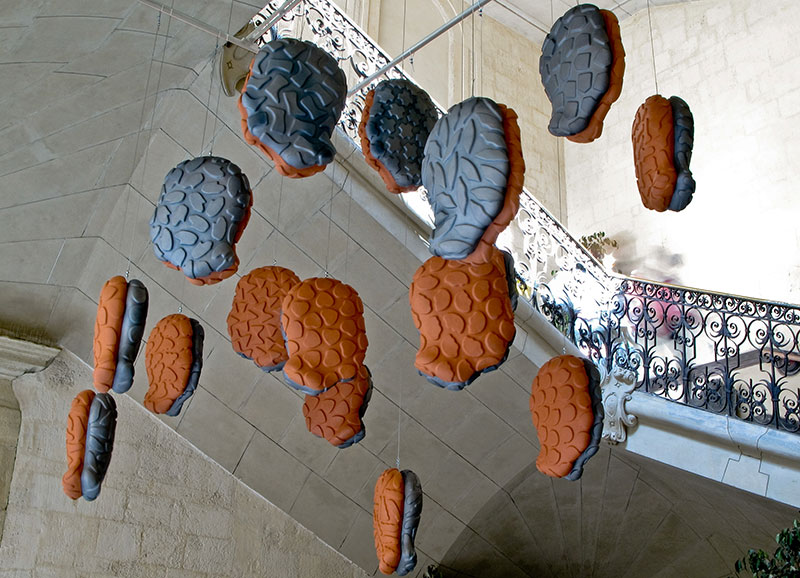
Concerning Things and Causes, which is the last of the series to be analyzed, the intention is to explain to everyone and to myself, an important part of the artistic project developed over a long period of time between 1988 and 2015. Twenty-seven years of activity that, looking back, have encompassed a large part of my connection with the fine arts, both as artist and teacher. I devoted my life to these occupations with the same intensity and developed as a whole; a whole with two closely related parts and, at this stage of my life, I am unable to discern which of the two seems more important in my interior development as an artist and as a person.
Things and Causes (2008-2015) ends for now, (for the purposes of this catalogue/project) with the series in which I have immersed myself in for the last six years, and which has overlapped for five of these years with the previous series, Illuminated interiors (2005-2015).
The series begins with a project for the wall, comprised of thirty-six pieces which was exhibited for the first time in May 2009, at Art Amsterdam, in a solo exhibition entitled: “Things and Causes”. This first work gives us keys as to what will construct the framework of the series in its entirety. Guidelines are set out that, like a chessboard, offer a complex relational scheme of images, figures, sketches or small models which allow the subsequent development of a series centered in its own essence, but also diverse in its spatial articulation and thematic complexity. These thirty-six small pieces bring together a whole universe of references in which I have moved in the last ten years. From a point of certainty and also from uncertainty, “the things” as much as “the causes” generate a complex web that knits a symbolic framework and opens the possibility to articulate a dialogue of affinities and opposites, producing meaning through chance operations and contradictory combinations.
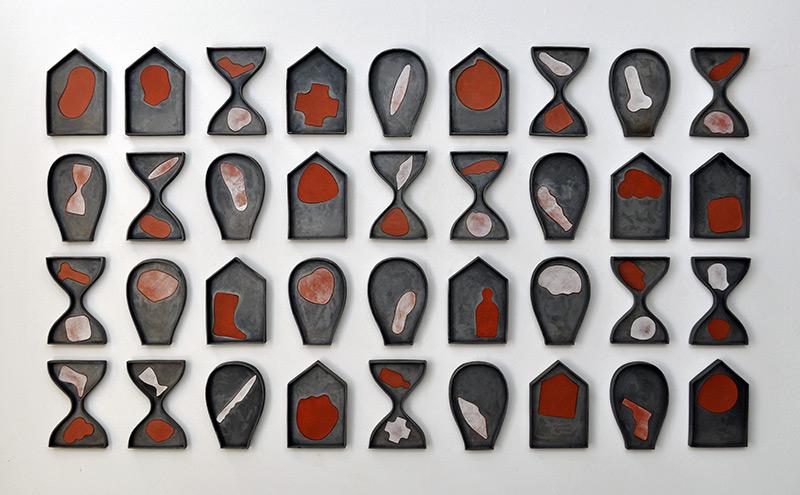
Things and causes, 2008. Clay. 24x16x3 cm. each piece.
(...) the thing about the size of the works is relative, I think that a large piece does not necessarily have more presence than a small one, the aura is not always equivalent to the size of the object, there are more powerful works and lesser works, as almost always, in this, it is also a question of luck. It can be a choice or not, although on occasions it is dictated by what you want to say at that moment, you are working on an idea and finally you have to make it in a certain size. We are talking about studio work proposals, given that when you begin a work that has to be placed in the urban environment there are questions of scale and an interrelation with what surrounds it, the architecture and other elements, such as street furniture, etc. In this case there are more determining aspects and therefore the scale is very important. But referring again to what would be studio work, the size is linked with the type of approach that the proposal you are about to undertake demands and the proportions of the various objects that comprise the proposal, it is determined by its relationship with the whole ensemble and its staging. 52
This wall piece has been shown under the same title of Things and Causes using three different installation approaches specific to each site. One of these installations was hung for the first time in 2010 in the Musée Languedocien in Montpellier. The installation was placed in the spacious area of the central staircase of the museum, a splendid baroque palace. A work comprising of sixteen pieces which represents heads, half red (red clay) and half black (red clay which has undergone a process of smoke firing). All the pieces are similar in shape and size, but at the same time are different given that each one, over the entirety of its area, has a tapestry of elements that differentiate them, denoting at the same time its bonds of identity and diversity. For this exhibition the pieces were displayed hung at different heights, taking into account the relationship with the surrounding space and the flights of stairs.
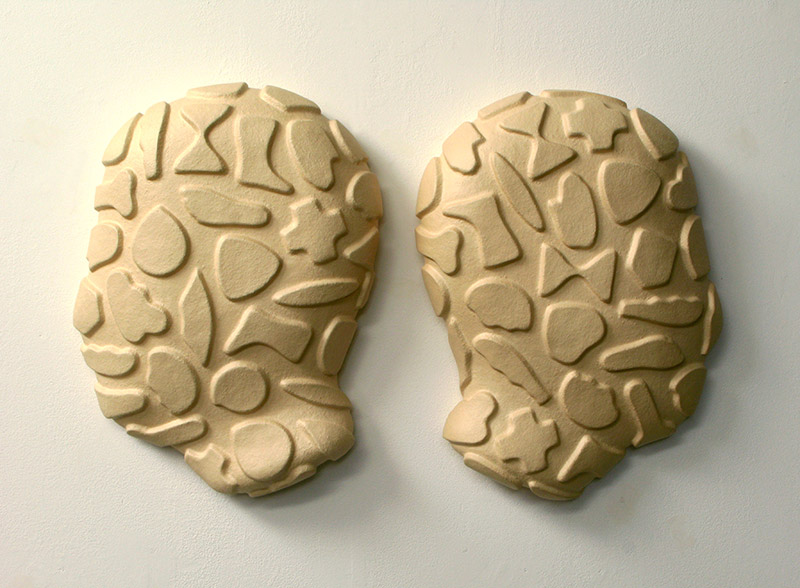
Things and causes, 2008. Grog stoneware. 53x80x11 cm.

Things and causes, 2008. Grog clay. 50x38x19 cm. each (16 pieces).
The work is comprised of 16 pieces suspended at different heights which suggest human heads half red, half black. Each one of these “heads” is articulated through a symbolic element that repeats over the entire surface, revealing aspects of human existence… as if it were about obsessions. 53
Based on the system of repetition and incorporating the possibilities of the ceramic process, I will show a series of pieces that allow the development of proposals that stem from repeated images. small elements are attached to the surface that run through the pieces saturating them with diverse images, with identical finish, showing their similarities, but also implicitly their differences.
Another of the proposals that I produced was destined for Taiwan. An exhibition organized by the National Taiwán Craft Institute, entitled “Spanish Ceramics for the XXI Century” the work was also shown in the Kaohsiung Museum and in the Yingge Ceramics Museum, over a period from April 2010 to February 2011. The work comprises various pieces of double heads, black and white, joined together at the neck, which have contrasting incrustations of different images in the upper part of the heads which function as associative links or as a reference of belonging.

Things and causes, 2008. Grog stoneware. 42 cm. height.
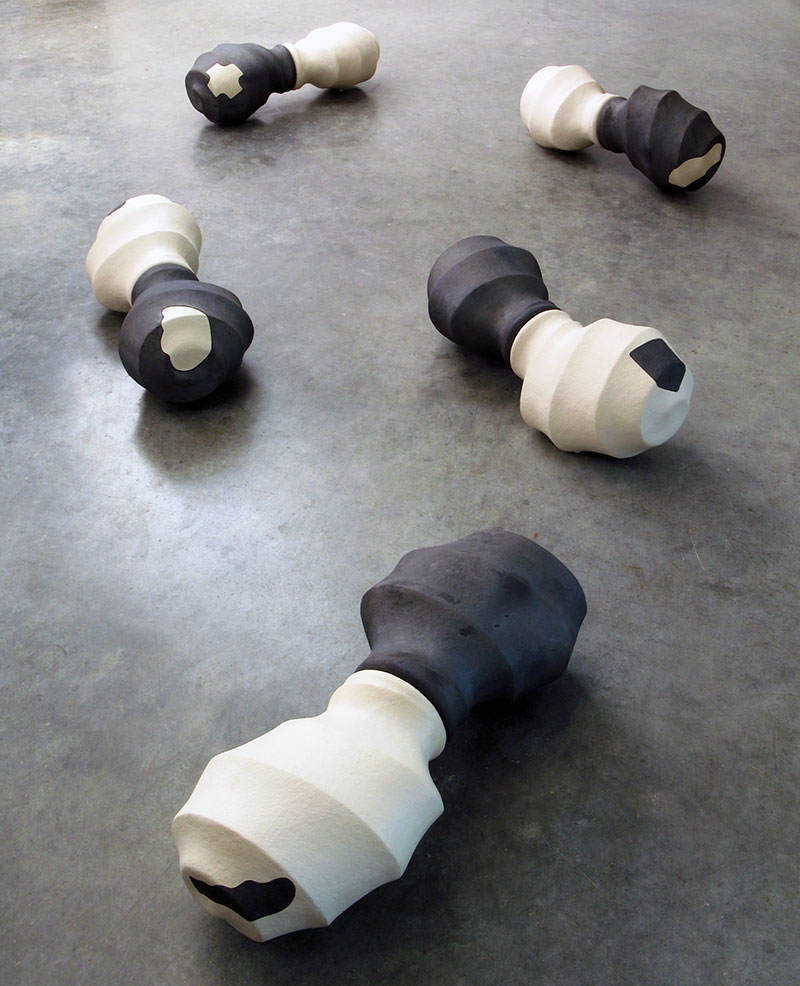
Things and causes, 2009. Grog stoneware. 30x82x30 cm. each (5 pieces).
In this and in other projects the two elements that form a single piece have their surfaces modified by the cutting and extraction of a small fragment, that, after being fired by a different process is reinserted into the space it came from. This process permits contrasting images that are based in the possibilities of serialization and similarity inherent in the casting process and in contrast, the unpredictable nature that is the very essence of the ceramic process. It is one way of altering the diverse meanings of the work in those cases where the staging shows the works as a group of identities. Through closer inspection and interaction, facets of unimaginable complexity are revealed to the viewer in their encounter and confrontation with them.
(...) My way of working and system of realization is varied but austere in procedures. The majority of my current works are realized in the following way: (…) I make prototypes in expanded polyethylene, plaster, wood or a combination of various materials. I take molds of these prototypes and begin to make the pieces with the clay specially prepared for each project. The pieces are made by pressing the clay by hand onto the mold, but they are individually modified so that each one has differences within the group, although barely noticeable in some cases, in others they are more significant because they are cuts or other types of manipulations. 54
In this series I’m going to resume and alternate the use of iron red clays fired at low temperature (1050 degrees) with the usual stoneware clays fired at 1150ºC and with beige tones or very close to white. As a contrast and in the search for a high chromatic contrast, I also use the process of extreme smoke firing in order to obtain metallic and smoke black finishes. Occasionally, I have used low temperature slips and glazes in some projects.
Fundamentally, I fire using an electric kiln, but the black colour is achieved through smoke firing in an airtight metal container that allows me to close it completely and obtain the black tones by burning wood.
I work more often with lighter coloured clays (white) as a question of concept, a contrast with the black. But I am interested greatly by the red clays, they awaken my interest because of their beauty, but in a certain way they are undervalued because of a question of hierarchy, a thing of the past, which is sometimes used when valuing ceramic supports (porcelain, stoneware, earthenware, red clay,…) but which however, from my point of view, have great possibilities.
The same occurs with the temperature, I prefer to cook at temperatures that do not involve added difficulties to the already complicated medium. Obviously, I waive certain qualities founded in extreme temperatures, but here as everywhere, you have to put your feet on the ground that suits your speech.
Another issue is the possible surface treatments. Long ago, I gave up modifying the materiality of objects. The material is who speaks, who builds the interior and is displayed on the surface. There is no color added. On one hand the clay, the matter; and on the other the smoke that blackens the latter. 55
The glazes I used occasionally in this series are used on small fragments, with the aim of accentuating a marked vitreous contrast with the rest of the piece, which have an earthy nature, with a very dry textural finish. I applied these processes to the wall piece Things and Causes, comprised of twenty-six pieces which were installed in the Jordana Espacio Gallery in Madrid for my solo exhibition there. It took place in 2010, and also for the intervention project (baptismal font and holy water font) which I carried out in 2013 for the new San Bartolomé church in Leioa, Bizkaia, commissioned by LGA, Architects.

Things and causes, 2010. Grog stoneware. 60x50x10 cm. each (26 pieces).
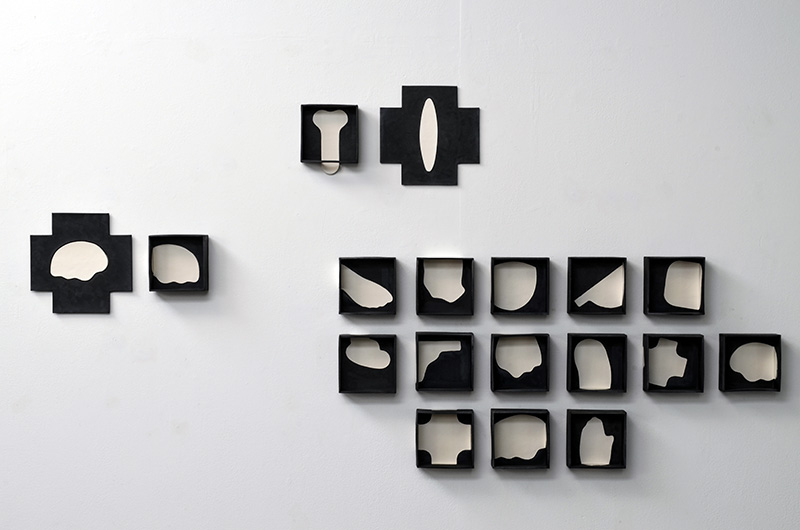
Things and causes, 2013. stoneware. Variable sizes.
At this moment (August 2015), I am immersed in two projects that I hope to conclude in the coming months. I say this because the vicissitudes, failures, doubts, and uncertainties that new proposals often entail are generally very frequent. And more so in this particular case given that I am facing certain evolving challenges that I have been trying to resolve these past few months. Finally it seems I can see the light at the end of the tunnel after modifications in the methodology of the work and substitution of certain materials, that for a great length of time have given me infinite problems that led to failures.
With the passing of time I have simplified and perfected the processes, I have professionalized them. I try to dominate the medium to the highest level possible so that the work flows as naturally as possible, expressed without leaving a trace. That is to say, that the objects are impeccable, that they appear natural, that they are born spontaneously, that they are not manipulated. I simplify the procedure, I isolate it and at the same time this allows me to control it because this control should not impede its expressive function. The result inevitably moves in a hybrid territory. 56
The experience of years of working has given me clarity, you accept the way you are. Time also makes you conscious that you contribute very little, to life, to art. You understand yourself, you are more sincere with yourself, you don’t feel the need to pretend, (…). For sure you feel more free and you know you are not going to collapse in the face of difficulties and problems. You have survived in the art world, continue being enthusiastic and desire to face new challenges. I believe that to maintain the willingness to dedicate your life to artistic practice, to what you really want, is a triumph. 57
The most recent two projects in this series are of considerable dimensions, one consisting of eight pieces each one occupying more than one square metre of floor space, but low in height and with the appearance of a tombstone, while the other arrangement of nine elements in a vertical configuration, has an approximately human scale. Both installations are designed to be obliquely separated in the exhibition space, leaving between them distances specific to the feeling of the site. The motivation for these works has been reinforced by the three solo exhibitions I have arranged for 2015: one is destined for the Foundation Santa María, Albarracín, Spain, the second for the De Witte Voet Gallery, Amsterdam, Netherlands and the third for the Centro Municipal de Arte y Exposiciones de Aviles, Spain. It is possible that these two proposals will conclude the series, but the possibility exists that they may continue. After forty odd years of uninterrupted professional activity the only certainties I have are the enthusiasm I maintain and the doubts that can halt my progress.
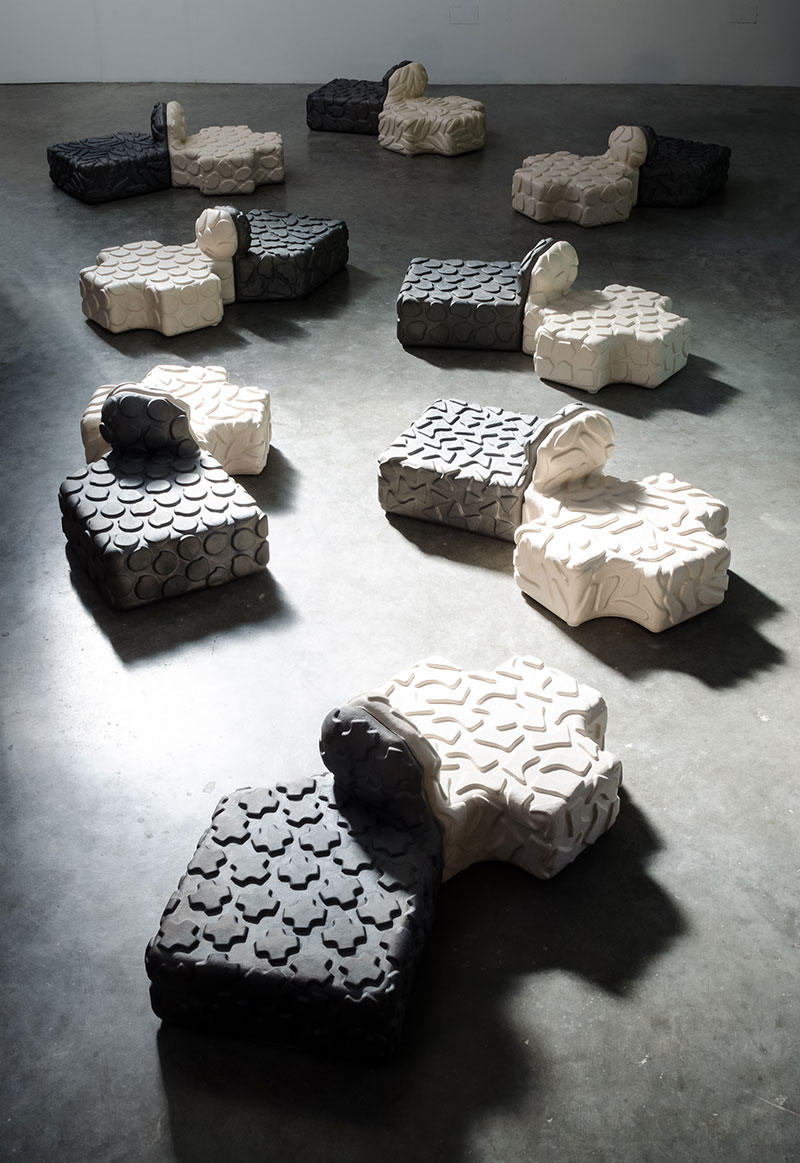
Things and causes, 2014. Grog stoneware. Dimensiones variables (8 piezas).
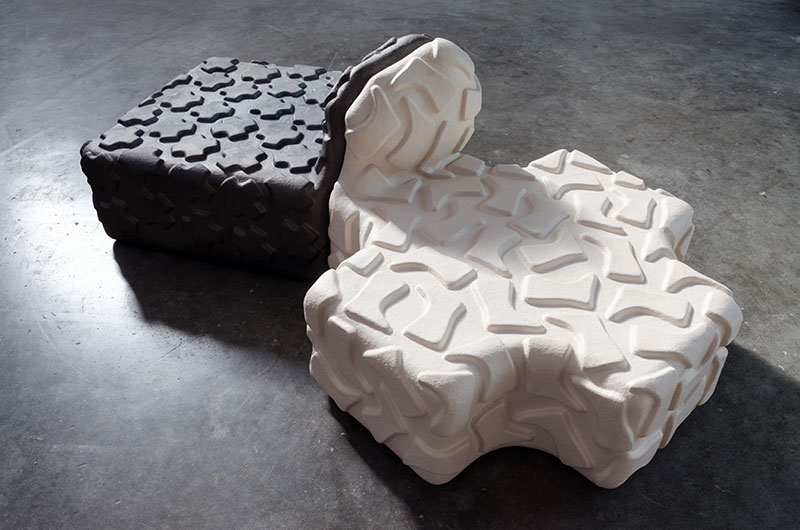
Things and causes, 2014. Grog stoneware. 39x120x65 cm.
I am conscious that I am not looking for answers, instead I am asking questions that I will never find answers to. I feel I am in the territory of incapacity, of impossibility, but I do not renounce the possibility to interrogate myself. (...) 58
Through my work I attempt to speak of what I know, but not to understand it, which in a certain way is Life: the mechanisms that make us sensitive towards pain, love, affection… Things that are well known, necessarily understood. 59
One does what one can, to try to get that expressive capacity (...).I would sometimes like to have a little more capacity to move peoples´ emotions, to motivate… and often without realizing it one continues to repeat oneself and does not reach this objective. This is surely the driving force of art, that one never manages to give a satisfactory account of oneself. 60
52 "Ángel Garraza. La luce, la terra e il fuoco". Laceramica (specialized magazine). Milan (Italy). pp. 3, 36-41. 2012.
53 "Things and causes". Regards complices (exhibition presentation text). Musée Languedocien, Montpellier (France). 22 Feb. 2010.
54 "Ángel Garraza". Terrart nº 40 (specialized magazine). Barcelona. pp. 5,20-24. 2012.
55 Ibid.
56 "Hacemos nuestro lo que de alguna forma necesitamos". Ángel Garraza. Maestros de la cerámica y sus escuelas (book / catalog). Zaragoza Council. p. 13. 2012.
57 "Conversaciones con Ángel Garraza". Ángel Garraza 1988-2006 (book / catalog). Fundación BBK. Bilbao. pp. 133. 2006.
58 "Hacemos nuestro lo que de alguna forma necesitamos". Ángel Garraza. Maestros de la cerámica y sus escuelas (libro / catálogo). Zaragoza Council. p. 16. 2012.
59 "Ángel Garraza. Contemplados" (exhibition presentation text). Astarté Galery, Madrid. p. 2. 2004.
60 "Ángel Garraza". Entreto2 (press). Estella. p. 22. 2003.
